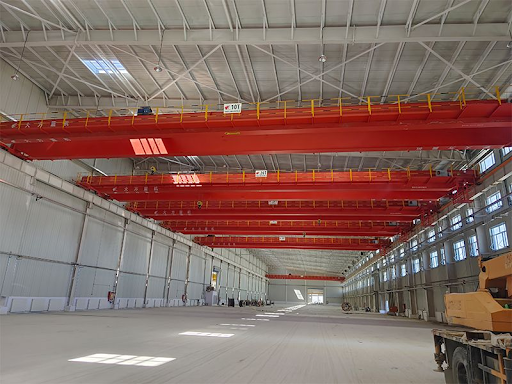In modern industrial sectors, cranes, as one of the fundamental pieces of equipment, play a critical role. From overhead cranes and gantry cranes to jib cranes, they are widely used across construction, mining, ports, logistics, and other industries. With evolving market demands and continuous technological advancements, the crane industry is facing unprecedented challenges and opportunities. How can companies stand out in this highly competitive market? Technological innovation is undoubtedly the key to boosting market competitiveness.
1. Technological Innovation: Enhancing Crane Efficiency and Safety
With the advent of Industry 4.0, intelligence and automation have become trends across all sectors. For the crane industry, technological innovation is primarily reflected in the following areas:
(1) Intelligent Control Systems
Traditional crane operations rely heavily on manual expertise, which can be cumbersome and prone to errors. However, the introduction of intelligent control systems has enabled modern cranes to achieve remote monitoring, automated controls, and fault diagnostics. These systems can monitor the crane’s operational status in real-time, ensuring efficient performance while minimizing risks caused by human error. For instance, IoT-based smart control platforms collect various data in real time, allowing enterprises to analyze equipment conditions, optimize maintenance schedules, and extend service life.
(2) Wireless Remote Control and Autonomous Operation Technology
The development of wireless remote control and autonomous operation technology has made crane operations more flexible and safer. Wireless remote controllers reduce physical contact between operators and machinery, significantly lowering the risk of accidents. In high-risk environments, cranes can be remotely operated for precise lifting tasks. Additionally, autonomous operation technology enables cranes to complete complex lifting tasks without human intervention, improving efficiency and safety.
(3) High-Efficiency Energy-Saving Technology
Energy conservation and environmental protection have become critical aspects of global industrial development. Cranes consume substantial energy during daily operations, making energy efficiency an essential focus for technological innovation. The introduction of electric drive systems, optimized mechanical structures, and high-performance motors can significantly reduce energy consumption and minimize environmental impact. Moreover, the utilization of renewable energy sources, such as solar power, is emerging as a key innovation in enhancing crane energy efficiency.
2. Market Marketing: Building Brand Competitiveness
While technological innovation boosts core product competitiveness, effectively communicating these innovative advantages to customers remains crucial. In terms of marketing, crane companies can employ the following strategies to enhance brand competitiveness:
(1) Market Segmentation and Precise Positioning
Different customer groups in the crane industry have varying needs. Companies should conduct market segmentation and accurately target their audience. For example, high-load, high-efficiency gantry cranes can be marketed to large construction projects, while rubber tyred container gantry cranes can be promoted to port logistics enterprises for container handling. Tailored marketing strategies based on segmentation improve customer satisfaction and loyalty.
(2) Strengthening Online Marketing
With the widespread use of the internet, online marketing has become an indispensable channel for traditional businesses. By creating corporate websites, optimizing SEO, and promoting on social media, crane companies can effectively showcase their technological advantages and product features. Additionally, using video content or virtual reality (VR) technology allows customers to understand product performance more intuitively, increasing purchase confidence.
(3) Offering Value-Added Services to Enhance Customer Experience
To secure market share, crane companies must not only provide quality products but also comprehensive value-added services. Regular maintenance, operator training, and remote fault diagnosis services can boost customer satisfaction and reliance. These services not only enhance the company’s reputation but also create additional revenue streams.
3. Business Model Innovation: Transforming to Explore New Markets
As market demands evolve, traditional crane sales models are no longer sufficient to meet the increasingly diverse needs of customers. Companies must innovate their business models to explore new revenue channels and market opportunities.
(1) The Rise of Rental Models
In many industries, customers often prefer leasing cranes instead of making significant upfront investments. This model helps companies expand their market, lower purchasing barriers, and increase sales. Additionally, rental businesses can provide stable, long-term cash flow, reducing financial risks.
(2) Customized Product Services
With technological advancements, customer requirements for cranes are becoming more specific. Companies can provide customized products and services based on customer needs. For example, a manufacturing enterprise requiring efficient material handling in a confined workshop might benefit from a tailor-made electric single girder underslung crane designed to maximize space utilization. Tailored configurations based on frequency and load demands further enhance customer satisfaction and differentiate companies in the market.
(3) Globalization Strategies
With the accelerated pace of economic globalization, companies should actively expand into international markets and leverage the immense potential of overseas demand. By collaborating with partners or agents, businesses can enter different countries and regions, diversifying market risks and increasing global market share. Additionally, cross-border operations facilitate technology exchange and brand influence, establishing a strong competitive edge on a global scale.
Conclusion
In the crane industry, the continuous pursuit of technological innovation, optimized marketing strategies, and innovative business models are the keys to success. By consistently improving technical capabilities, refining marketing approaches, and exploring new commercial avenues, crane companies can distinguish themselves in a competitive market. As technology advances and market demands diversify, the crane industry will face new challenges and opportunities. Only by embracing innovation can businesses maintain their leadership and achieve sustainable development.






